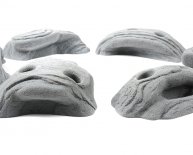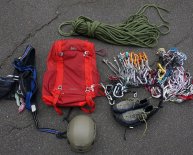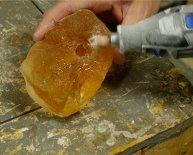
Crack Climbing holds
|
Finger Cracks |
THUMBS UP - PINKY JAM |
1. For the thinnest cracks, use a thumbs up position to allow you to slot your pinky and ring finger. Look for a constriction in the crack and slide your hand in above it and pull down to set the jam. |
2. You'll get a secure jam if you can slot your first knuckle just above the constriction so it gets wedged in tight when you pull down. For a tighter lock, cam your hand inward, towards your thumb. |
THUMBS DOWN | 1. As the crack widens you may be able to slot the thumb too. | 2. Stack your fingers and cam your hand by rotating your elbow inward. |
Hand Cracks
|
|
Fist Cracks |
Uh oh! too wide for a hand jam... what to do? |
As the crack widens notice how the fingers are crimped all the way down, but they are beginning to lose purchase on the right side of the crack. |
Turn your fist palm down and ball up your fist, clenching tight to expand the fleshy part of your palm to create counter pressure. |
"Hidden Booty" - Taking a look or feeling around in a crack can sometimes yield hidden treasures, consider the following examples: |
|
Footwork | With hands it is easy to alternate between a thumbs up and thumbs down position because your wrist offers such a wide range of motion. But your ankles are a lot less flexible. Try this experiment, sitting in a chair, rotate your foot into a "big toe up" position and then try a "big toe down" position. Which feels more natural? Which position keeps your center over your feet? |
1. With a secure hand hold to lock off on, my body weight is supported by a smear as I move my foot up and rotate it to slot it above a constriction in the crack. |
2. Twisting my knee inward cams the foot in the crack and puts my leg in a good position to stand up keeping my center over my feet. Since this crack flares out, I can also get some friction from the sides of my shoe if I keep my heel down putting more rubber from my sole onto the rock. | Stemming | Stemming is a great way to make gravity work in your favor to get a rest position or ascend a seemingly blank wall. |
|
Layback |
If you can't get your body position for decent jamming, consider a layback. The key to a good layback is keeping your body positioned so you get the best use of your legs. If your feet get too high, you're not standing on them and the only way you can keep from falling is to create massive oppositional force by pushing with your legs and pulling hard with your arms. On the other hand, if you move your hands up too quickly and let your feet get too low, you'll lose the pressure needed to drive your shoes into the wall and you'll find yourself sliding down, scraping the rubber off of your shoes as you go. Jay keeps his arms straight, saving his biceps while ascending a crack that is too close to the corner to allow his body to get in position for jamming. |
Making a Tape Glove | Although, its not necessary, a well made tape glove will save the skin on the back of your hand and make for more secure hand jams. Its a skill well worth having if you plan to spend a day on crack. Drawings from Metolius. |

















